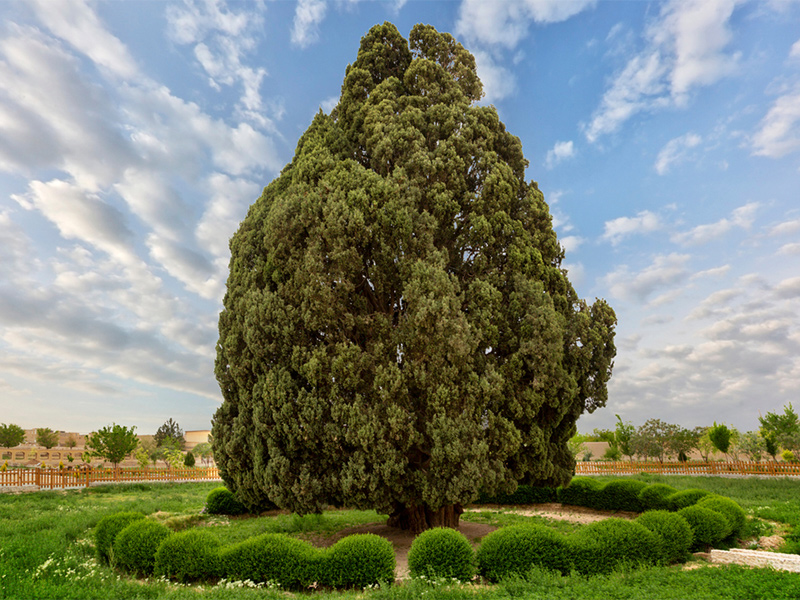The Abarkuh Cypress tree in Yazd, Iran, is considered one of the unique natural wonders and a must-visit attraction in the city of Abarkuh, located in the Yazd province. It stands tall with a rich history in the heart of Iran’s central desert, shining like a valuable emerald with its green color. In this article from Eligasht, we will introduce you to Iran’s oldest living tree and explore the stories and narratives that testify to the existence of ancient civilization in that region.
Book Iran Air flights from London to Tehran and Tehran to London with Eligasht UK:
Introduction to the Ancient Abarkuh Cypress, the Oldest Tree in the World in Yazd
The Abarkuh Cypress, situated in the Yazd province, is regarded as the oldest living being in Iran. This ancient and venerable tree has witnessed numerous ups and downs throughout its long lifespan and after centuries have passed, it remains magnificent, proud, and powerful.
The significance of the Abarkuh Cypress goes beyond its natural beauty; it carries an inseparable link to the culture and beliefs of the local people and a corner of Iran that keeps the tired soul of this tree vibrant, verdant, and fertile. It is difficult to determine whether it is the soil that has embraced and preserved the ancient Abarkuh Cypress or if it is the magical roots of this millennia-old tree in the Yazd province that have kept the land suspended and elevated amidst the heavens.
Size of the Abarkuh Cypress
The Abarkuh Cypress belongs to the Mediterranean cypress tree species and specifically to the Shirazi variety. Its scientific name is “Cupressus sempervirens.” The crown of this tree measures approximately 11.5 meters, and its height reaches 25 to 28 meters. The robust Abarkuh Cypress in the Yazd province, with a trunk diameter of four meters, astonishes and amazes its visitors. Some of its branches even extend up to 1.85 to 2.5 meters, truly remarkable. The trunk of the Abarkuh Cypress in the Yazd province is twisted and spiral, captivating tasteful travelers who liken it to the glorious history and inseparable authenticity of the people of this country.
The Abarkuh Cypress tree, located in Abarkuh, remains fruitful and evergreen after several thousand years. While it stands in an open space, the relevant authorities have surrounded it with protective barriers to prevent potential harm to the tree. However, the generous and benevolent Abarkuh Cypress extends its caressing hand to visitors through its branches, which pass through the barriers, symbolizing the proud history and indistinguishable authenticity of the people of Iran.
Visiting the Abarkuh Cypress
Undoubtedly, seeing pictures of the Abarkuh Cypress tree cannot compare to visiting it in person. That is why many tourists travel to Yazd to witness this tree, and some even consider it a pilgrimage. The peak of the Abarkuh Cypress’s grandeur can be witnessed in the middle of spring when, after all these years, it remains fruitful, evergreen, and beautiful. In autumn, the Abarkuh Cypress presents a contrasting landscape with its pleasant green color amidst its surroundings.
The Desert Regions of Iran, are home to numerous ancient trees due to their unique climate. The younger sister of the Abarkuh Cypress, the 1,200-year-old cypress tree, has been registered as a natural heritage of Iran, just like its older counterpart. According to a report by the Environmental Protection Agency of Yazd province, there are 60 other ancient trees with a long history in the province of Yazd. However, the Abarkuh Cypress is so unique and special that it has gained worldwide fame, and its name is familiar to many people.
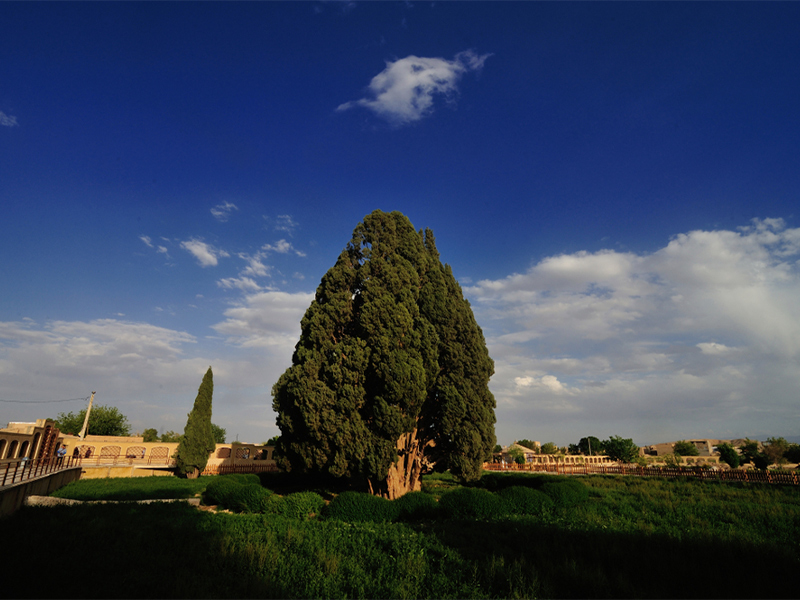
Where is the Abarkuh Cypress located?
Abarkuh, also known as Abarghoo, is a historic and authentic city located in the Yazd province. It is situated in the central desert region of Iran. Abarkuh is positioned on the Yazd-Shiraz highway and is part of the golden triangle of tourism in Iran, which includes the beautiful and populous cities of Isfahan, Shiraz, and Yazd. Although Abarkuh is recognized as one of the 14 exemplary tourist cities of Iran, its main feature is undoubtedly the cypress tree, which carries a history of thousands of years. The Abarkuh Cypress, or Abarghoo Cypress, is considered one of the most famous and beautiful tourist attractions in the Yazd province, and visiting it is easily possible.
Address of the Abarkuh Cypress: Abarkuh, Nezamiyeh, Shahid Beheshti Street, Sarv Street
How old is the Abarkuh Cypress?
Without a doubt, the Abarkuh Cypress tree has a long history and a considerable lifespan. This can be understood at first glance from the reverence that this tree evokes, setting it apart from other trees. “Hamdollah Mostowfi” first mentioned the Abarkuh Cypress in his book “Nuzhat al-Qulub” in 740 AH (1339 CE). But how many years has the Abarkuh Cypress been living? “Alexander Rouf,” a Russian scientist, estimated the age of this tree to be between 4,000 to 4,500 years. However, it has been reported that a Japanese scientist introduced the Abarkuh Cypress at the age of seven to eight thousand years, but this claim lacks reliable sources. Nevertheless, according to a report published in 2012, the Abarkuh Cypress is now considered the oldest living organism, after a plant called “Matusal” or “Metushelach,” in the White Mountains of California.
The Cypress Tree in People’s Beliefs
The ancient and magnificent cypress tree with a history of 4000 years in Abarkuh has gained a special place among the local people and tourists due to its remarkable and awe-inspiring age and grandeur. It has found its way into their beliefs and has been recorded, although many of these beliefs have not been proven and are far from reality. The most common public belief regarding the Abarkuh cypress tree is that it was planted by Zoroaster. For this reason, the cypress is also known as “Zoroaster’s Cypress” and is sometimes referred to by this name.
The name of the ancient and authentic cypress tree of Abarkuh is associated with other figures such as Alexander the Great, Zahhak, Abraham, and the Prophet Solomon, and planting or visiting this tree is attributed to them in existing narratives. Another written narrative states that Noah and his descendants planted the Abarkuh cypress tree in gratitude for being saved from the flood, and this tree has remained magnificent, fresh, and green since that time.
In this narrative, it is mentioned that “Yaft,” the descendant of Noah, was the one who first planted the cypress sapling in the soil of this region. The Abarkuh cypress tree is also considered one of the 12 sacred trees revered by the companions of the prophet “Ras.” Despite the curse by their prophet and the destruction of the region, the cypress tree remained upright and continued its life. Due to its 4000-year history, the Abarkuh cypress tree is respected and honored by the people and Muslims in Yazd and its surrounding region, as it is located on the Silk Road and the pilgrimage route to Mashhad. Today, some religious ceremonies are held around this tree.
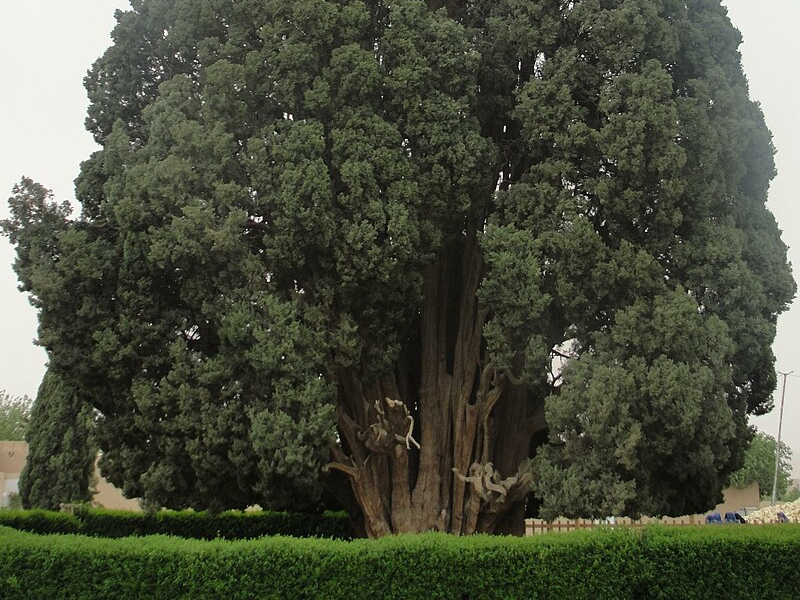
Marco Polo and a Narrative of the Abarkuh Cypress Tree
Marco Polo, a Venetian explorer and merchant, mentioned the Abarkuh cypress tree in his book. His book, “The Travels of Marco Polo,” known as “The Wonders of the World,” is remarkable and fascinating. In his travels to the Abarkuh region in the 13th century, he described the cypress tree as follows:
“One of the cypress trees I have visited in Iran is a cypress tree in the Abarkuh region. It falls onto the land of Abarkuh like a green waterfall from the sky, and from every direction you enter Abarkuh, you encounter an ancient, fresh, and green cypress tree, like a green lighthouse that calls us to the port of the desert sea and the shining sun, welcoming us.”
The Cypress Tree in Iranian Culture and Literature
The cypress tree is considered the national tree of Iran, and it is registered as such in the list of national trees of the world. Since the cypress tree is always green and resistant, remaining magnificent and green in all four seasons and difficult environmental conditions, it has been regarded as a symbol of freedom and resilience. The cypress tree has also manifested itself in the poetry of Hafez, Saadi, and many other esteemed poets, and in addition to its previous meanings, it has been repeatedly compared to the stature of the beautiful ones.
The symbol of the cypress tree can also be found in Iranian ancient artifacts, indicating its deep value and significance in the rich Iranian culture. One of the symbols frequently found in Persepolis is, in fact, the cypress tree, and in every corner of this ancient Iranian structure, traces of it can be found for admiration. Even after the Arab invasion of Iran, the ancient symbol of the cypress did not disappear from Iranian culture and, in the most beautiful form possible, appeared in their art as curved and broken, speaking of countless untold stories and reflecting the passage of the ancient glorious era. Today, the curved cypress tree is called “Boteh-Jeqeh” in Iranian art and handicrafts, which has also been exported to other cultures and is recognized among them.
Burning of the Cypress Tree in Abarkuh
During the Persian New Year of 1395, the news of the burning of the 4,000-year-old Cypress tree in Abarkuh had a profound impact on everyone. Fortunately, shortly after the release of this news, Seyyed Nabi Rasouli, the former governor of Abarkuh, strongly and decisively denied the issue and took action against the publishers who spread these falsehoods. The rumor of the Cypress tree burning in Abarkuh was indeed baseless and untrue; however, the reality is that this majestic and evergreen tree has been subjected to harassment by visitors throughout the years of its existence. People have damaged it by carving inscriptions, breaking branches, and climbing on it, causing significant harm to this tree, which is deeply concerning for its proud existence, and we must make sufficient efforts to preserve it.
Apart from that, due to reckless well drilling and disruptions in the paths of qanats (underground aqueducts) and groundwater, this tree has suffered from drought, causing it to age prematurely and diminish its eternal splendor. This is a regrettable and thought-provoking matter.
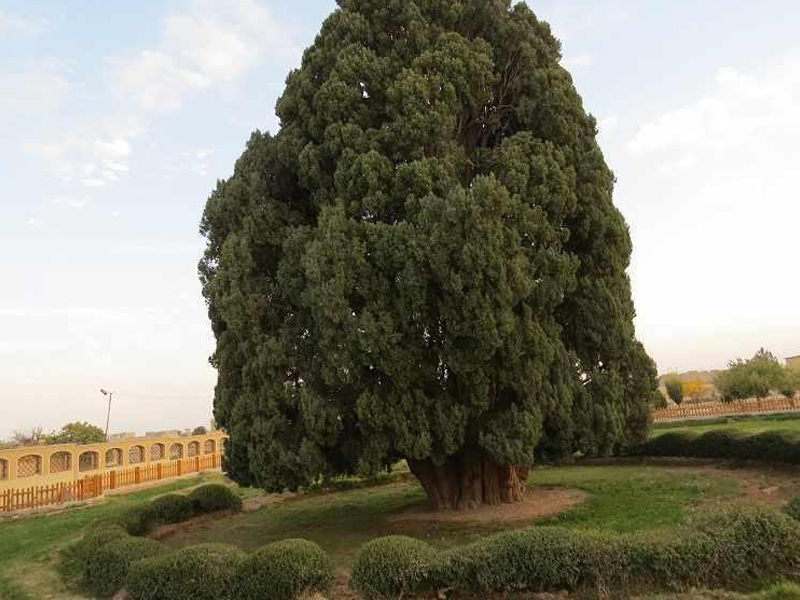
Preserving Iran’s Natural Heritage
Henceforth, it is highly deserving that we make efforts and collaborate to give more importance to nature so that we can successfully preserve such valuable treasures. In recent years, the Cultural Heritage, Tourism, and Handicrafts Administration of Yazd Province has provided the prerequisites for the preservation and revival of the Abarkuh Cypress tree, and we hope to witness its former grandeur in the future. These prerequisites include fencing, biological intervention, lightning protection installation, and assistance from foreign experts. The Abarkuh Cypress tree was registered as a national natural heritage in February 2004, and efforts are underway to include it in UNESCO’s list of natural sites.
Why is visiting the Abarkuh Cypress tree in Yazd recommended?
This magnificent Cypress tree has been registered as one of Iran’s national natural treasures in the National Heritage list since 2003. This tree is considered one of the oldest living organisms in the world, surrounded by numerous myths and legends. The Cypress tree is an important symbol in ancient Iran, and visiting it is suitable and highly thrilling for history enthusiasts.
Cost and Time of Visit
You can visit this tree every day from 8 am to 6 pm and experience the indescribable pleasure and pride in the resilience of this tree. However, to visit this natural attraction, you need to pay an entrance fee, and the recommended duration for the visit is approximately 2-3 hours.
related post
see the tallest wind catcher in the world in the Dowlat Abad Garden in Yazd
The sights of the Karakal Desert in Yazd will leave you amazed!
Best Time to Travel to Abarkuh Region, Yazd
Yazd is located in a desert region and has a hot and dry climate. Therefore, cooler seasons, such as winter, autumn, and spring, are the best times to travel to this city. The autumn season, with its beautiful colors, is considered the best time to visit Abarkuh and see its ancient Cypress tree.
Tourist Attractions near the Abarkuh Cypress Tree in Yazd
Distance from Soult House to the Abarkuh Cypress Tree: 1.2 kilometers
Historical House of Aghazadeh: 1.3 kilometers
Jameh Mosque of Abarkuh: 1.4 kilometers
Imamzadeh Ahmad: 1.8 kilometers
Icehouse (Yakhchal) made of mud bricks: 2.8 kilometers
Rabat Castle: 5.2 kilometers
Gonbad-e Ali: 6.2 kilometers
Hotels and Accommodations near the Abarkuh Cypress Tree in Yazd
Distance from Sarv Kohan Eco Lodge to the Abarkuh Cypress Tree: 140 meters
Hossein Mirza Eco Lodge: 1.2 kilometers
Edalat Hotel Guesthouse: 2.3 kilometers
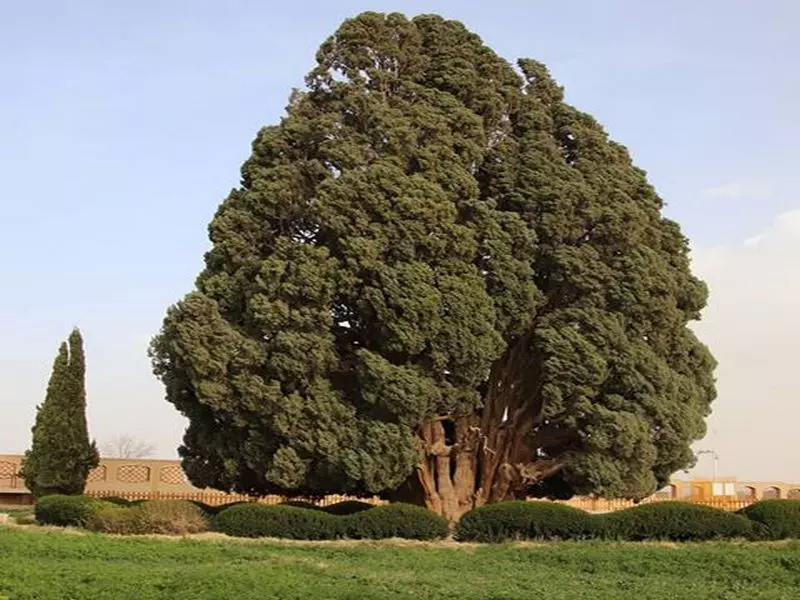
Final words
The Abarkuh Cypress tree in Yazd, with a history of 4,500 years, is the second oldest tree in the world and one of the oldest living organisms on Earth. This ancient tree is a symbol of resilience and sustainability in Iranian culture and is highly fascinating for history and nature enthusiasts.
FAQ
-
Where is the Abarkuh Cypress tree located?
The Abarkuh Cypress tree is located in Abarkuh County, Yazd Province, in Imam Hussein Square.
-
How old is the Abarkuh Cypress tree?
between 4,000 to 4,500 years old.
-
Why is visiting the Abarkuh Cypress tree in Yazd recommended?
– registered as a national natural heritage in Iran.
– one of the oldest living organisms in the world.
– It is an important symbol in ancient Iran.
